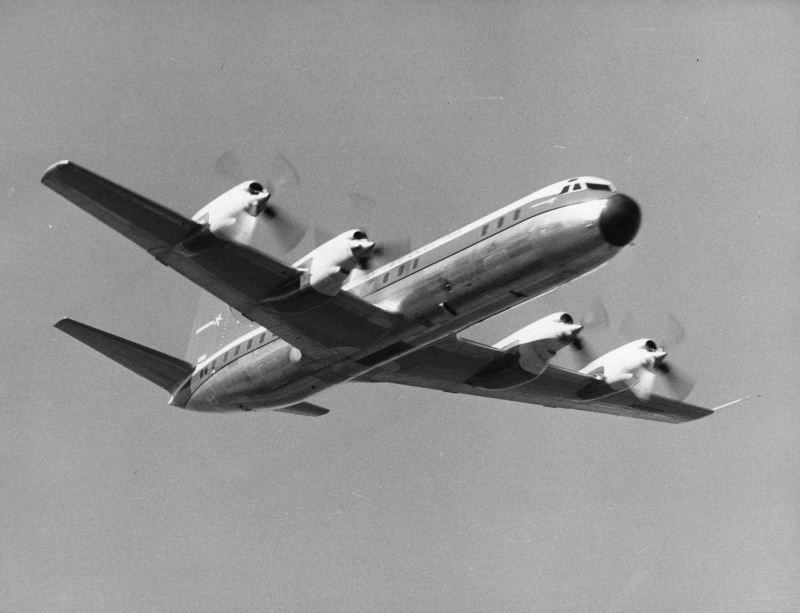
 6 December 1957: At 10:28 a.m., Lockheed Aircraft Corporation’s Chief Engineering Test Pilot Herman Richard (“Fish”) Salmon, and co-pilot Roy Edwin Wimmer started the Number 4 engine (outboard, right wing) of the new prototype Model L-188A Electra, c/n 1001, registered N1881. Also on board were flight engineers Louis Holland and William Spreuer. In rapid succession, the flight crew started engines 1, 2, on the left wing, and 3, inboard on the right. The prototype then taxied to the eastern end of Lockheed Air Terminal’s Runway 27.¹ At 10:44, Salmon released the brakes and the Electra rapidly accelerated down the runway. It was airborne in just 1,800 feet (549 meters).
6 December 1957: At 10:28 a.m., Lockheed Aircraft Corporation’s Chief Engineering Test Pilot Herman Richard (“Fish”) Salmon, and co-pilot Roy Edwin Wimmer started the Number 4 engine (outboard, right wing) of the new prototype Model L-188A Electra, c/n 1001, registered N1881. Also on board were flight engineers Louis Holland and William Spreuer. In rapid succession, the flight crew started engines 1, 2, on the left wing, and 3, inboard on the right. The prototype then taxied to the eastern end of Lockheed Air Terminal’s Runway 27.¹ At 10:44, Salmon released the brakes and the Electra rapidly accelerated down the runway. It was airborne in just 1,800 feet (549 meters).
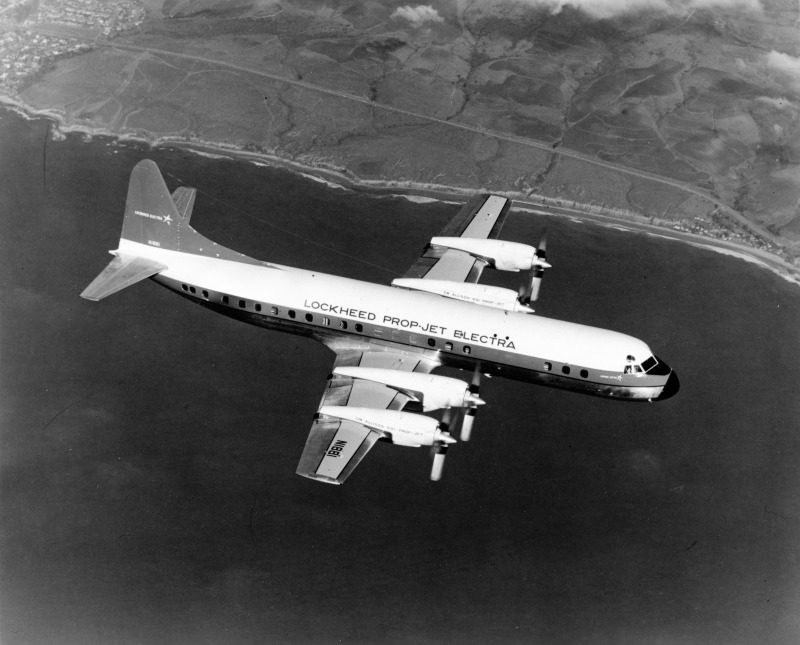
Fish Salmon took the prototype to the U.S. Navy’s restricted missile test ranges off the southern California coastline, flying between Naval Air Station Point Mugu and San Diego. During the flight, the Electra reached 400 miles per hour (644 kilometers per hour) and 14,000 feet (4,267 meters). Salmon radioed, “She controls beautifully. No sweat.”
The Electra was followed by two chase planes, a Lockheed T-33A Shooting Star, and a Super Constellation airliner. After the initial flight test, Salmon returned to LAT, landing after a flight of 1 hour, 27 minutes. The test flight was made 56 days ahead of schedule.
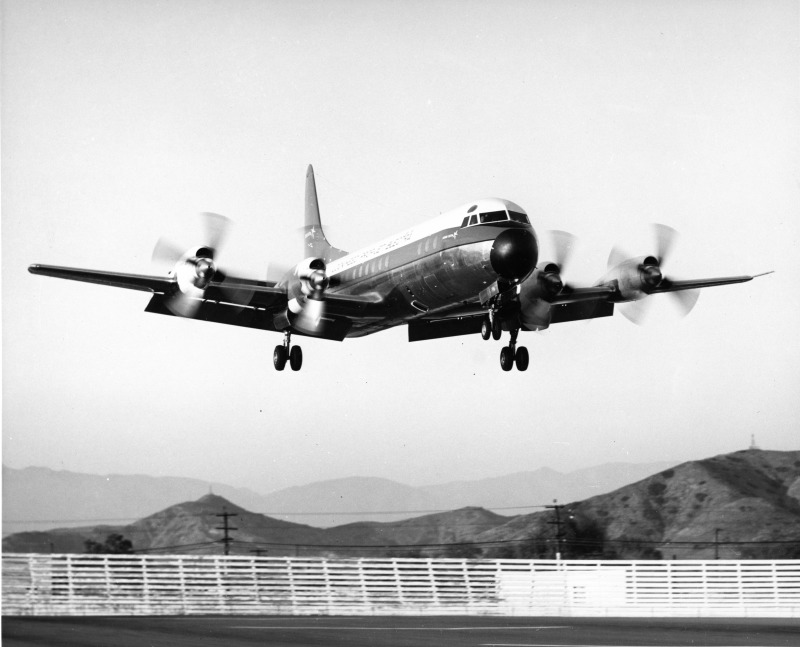
Lockheed retained N1881 as a test aircraft until April 1961, when it was sold to Friedkin Aeronautics and re-registered as N174PS. It was operated by Pacific Southwest Airlines (PSA) from May 1961 until October 1968, when it was sold to Holiday Airlines and re-registered as N974HA. The Electra was withdrawn from use and stored at Van Nuys Airport (VNY), just a few miles west of BUR, in October 1968. It is reported to have been scrapped in 1975.
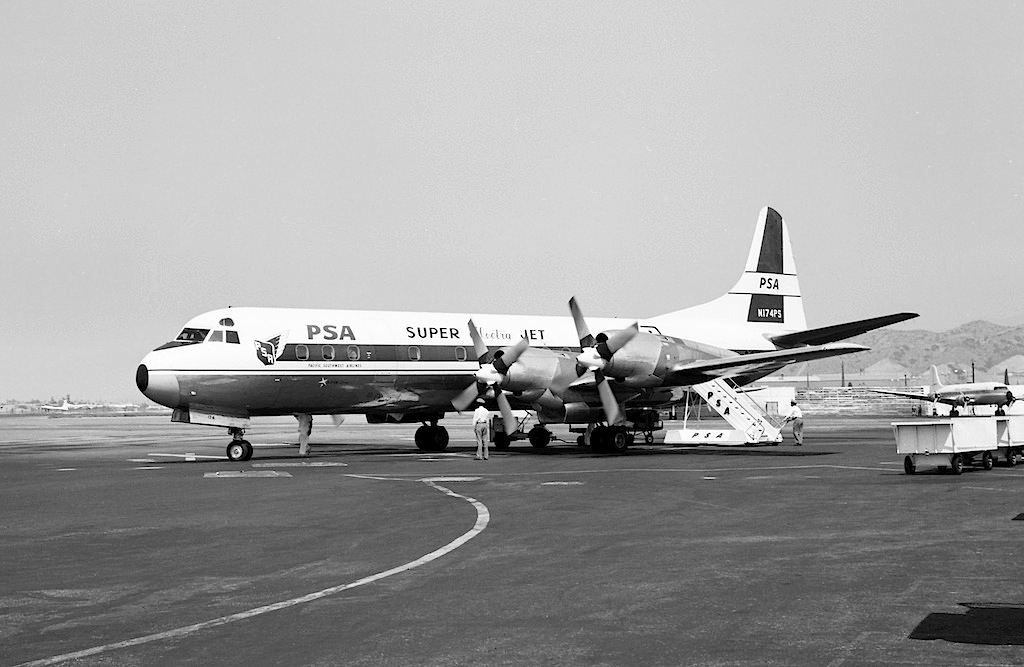
The Lockheed Model 188A Electra is a four-engine, low-wing, commercial airliner with retractable tricycle landing gear, and powered by four turboprop engines. It was operated by a pilot, co-pilot and flight engineer, and could carry a maximum of 98 passengers. The L-188A was the first production variant. It is 104 feet, 6.5 inches (31.864 meters) long, with a wingspan of 99 feet, 0.00 inches (30.175 meters), and overall height of 32 feet, 11.6 inches (10.048 meters).
 The L-188A was powered by four Allison Model 501-D13 (T56-A-1) turboprop engines. The -D13 is a single-shaft axial-flow gas turbine engine. It had a 14-stage compressor, 6-tube combustor, a 4-stage turbine. It was rated at 3,750 shaft horsepower at 13,820 r.p.m. The engines drove four-blade, square-tip Aeroproducts propellers with a diameter of 13 feet, 6 inches (4.115 meters), at 1,020 r.p.m. The -D13 is 12 feet, 1.0 inches (3.683 meters) long, 2 feet, 3.0 inches (0.686 meters) wide and 3 feet, 0.0 inches (0.914 meters) high. It weighs 1,750 pounds (794 kilograms).
The L-188A was powered by four Allison Model 501-D13 (T56-A-1) turboprop engines. The -D13 is a single-shaft axial-flow gas turbine engine. It had a 14-stage compressor, 6-tube combustor, a 4-stage turbine. It was rated at 3,750 shaft horsepower at 13,820 r.p.m. The engines drove four-blade, square-tip Aeroproducts propellers with a diameter of 13 feet, 6 inches (4.115 meters), at 1,020 r.p.m. The -D13 is 12 feet, 1.0 inches (3.683 meters) long, 2 feet, 3.0 inches (0.686 meters) wide and 3 feet, 0.0 inches (0.914 meters) high. It weighs 1,750 pounds (794 kilograms).
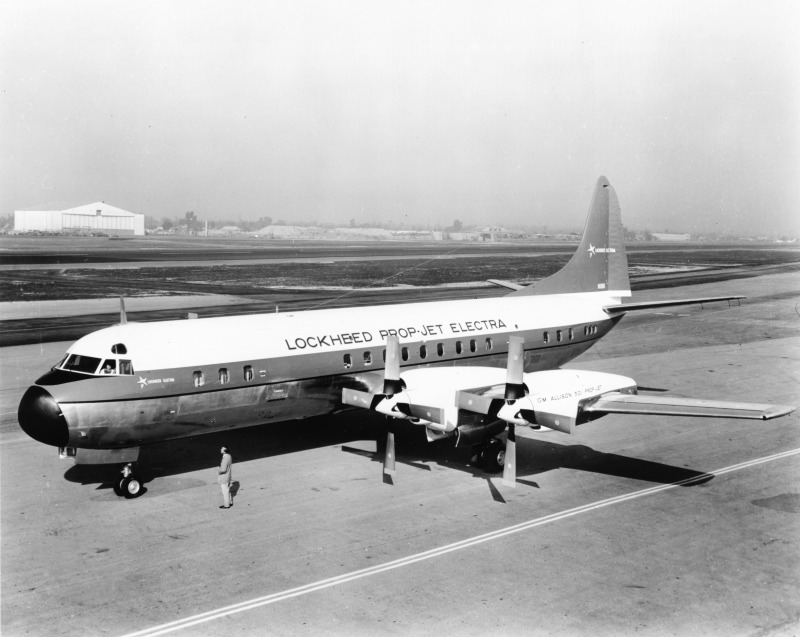
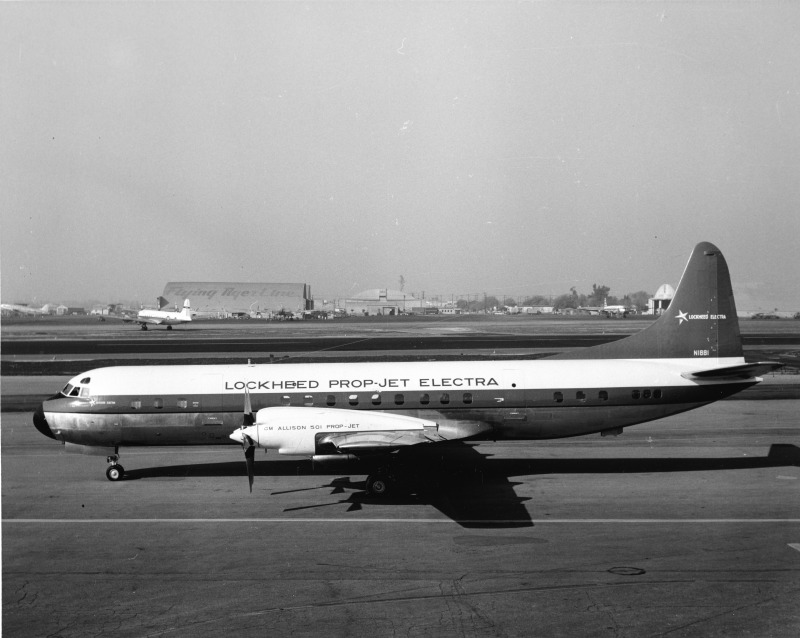
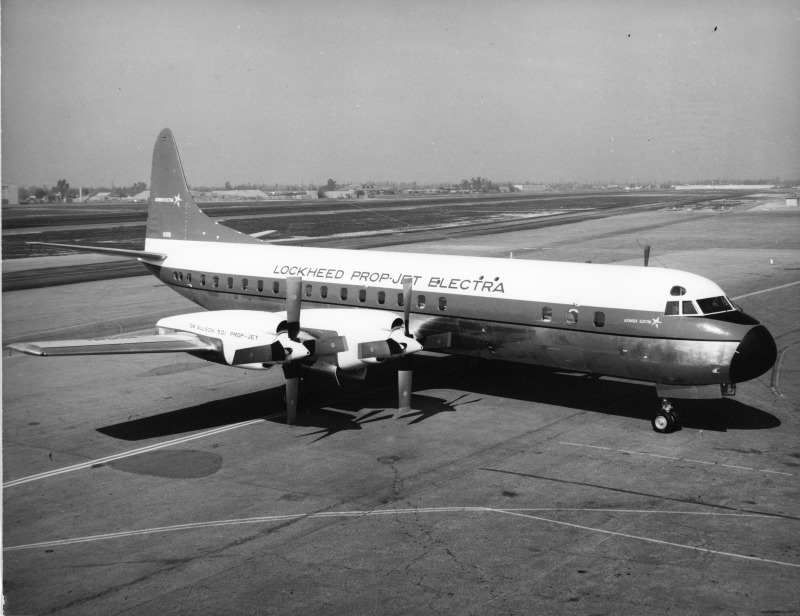
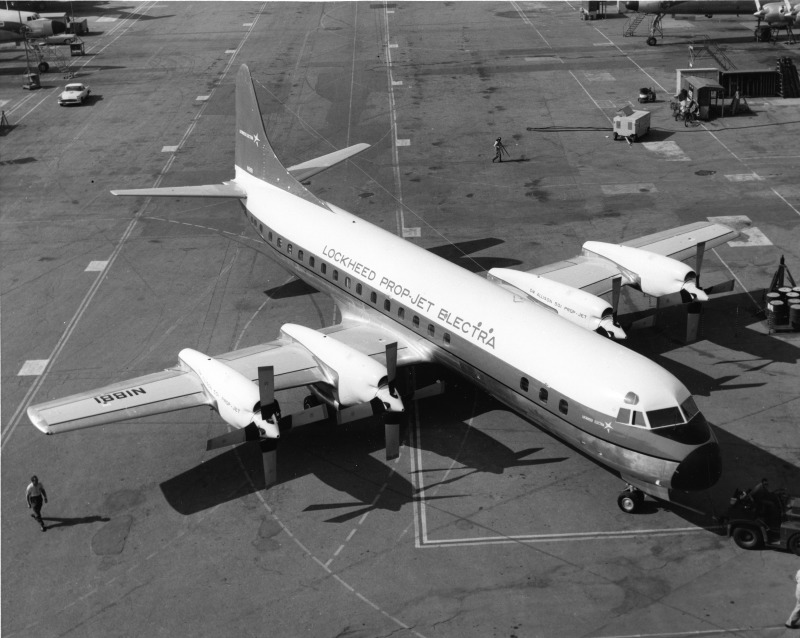
Critical Mach Number (Mcr) = 0.711
¹ In 1967, the name of the Lockheed Air Terminal was changed to Hollywood-Burbank Airport. After several more name changes, including Bob Hope Airport, it is once again known as Hollywood-Burbank. Its FAA identifier is BUR.
© 2018, Bryan R. Swopes
It would be interesting to know if the runway has changed it’s designation. The east-west runway at Burbank KBUR is now 8-26.
Yes. The magnetic north pole has shifted position enough that many runways’ compass direction have had to be changed.
23 of these aircraft are currently on the Canadian Civil Aircraft Register though not all are flying. Most are water bombers.
Buffalo Airways at CYZF has 2 I believe!
Eastern Airlines flew some Electra’s as did Capital Airlines. Lockheed once a producer of really great revolutionary aircraft designs has disappeared from the world stage as has so many others like Douglas, Convair, Grumman, MacDonald sad
In 1968, while standing on the grass beside our Cessna 140 at Highway 77 Airport south of Dallas, my roommate Larry and I were telling our non-flying girlfriends about our plane and flying in general. Without interrupting the ongoing conversation, Larry and I glanced off to the south, saw a black speck in the sky, muttered “Lockheed Electra” to each other and continued the conversation. Both girls said, “Wait, stop–what is that?” We said, “Lockheed Electra.” They said, “It’s a black SPECK in the sky! How do you know what it is?” We assured them that we knew our black specks, and, seconds later, as the Lockheed Electra passed overhead descending into Love Field, we shared with them that, even if it was cloudy, we could identify it by sound as well.
Great story, Richard! 🙂 —TDiA
No mention of the number of P-3 Orion’s that were built from this design.
. . . nor the CP-140 Aurora. . . .
AS a gate agent for Eastern Airlines in 1962-65 I boarded many passengers on the Electra. It was quite a different aircraft from the previous piston aircraft I had worked. It was quite a sight to see the aircraft pull into the gate and feather those engines
Universal (Zantop) Airlines operated 13 Electra freighters out of Willow Run airport starting in the late 60’s. Most were acquired from KLM along with a Link flight simulator. I worked on the simulator, helping acquire FAA certification for it and then operation and maintenance. Love that airplane as well as the P-3. What an improvement over the P-2
Air Spray out of Red Deer Alberta operates 9 L-188s in the airtanker role. We also acquired the simulator nearly 10 years ago. The sim is now digitized and is used to train airtanker pilots
Sure is nice they figured out a way to keep the wings from falling off. Too bad about the first few.
Propeller Whirl Flutter: https://www.nasa.gov/topics/history/features/rn_tdt50.html
The P-3 … That came out in 1958 didn’t it? I remember I liked the looks of the P-2.
First flight, November 1959. Full disclosure: TDiA worked in P-3 final assembly at Lockheed Burbank in 1969.
My 12th birthday present was a flight in a PSA Electra from Burbank to San Diego. November 1958.
I remember flying on an Electra. I believe it was an Eastern shuttle from LaGuardia to Washington.
Clearly remember Northwest Airlines L-188 Electras at the old FTL Airport in the late 50’s. The gates (concourses) were outside and you could see your friends off to the point they walked onto the tarmac to the A/C. My father frequently flew to Chicago for business on these NWA flights. On 1 business trip, the day my father planned to fly back from Chicago, March 17, 1960, an NWA Electra from Chicago en route to FTL crashed in Tell City, IN. No survivors. I was sure my father was killed. Turns out he was not on that flight but for a 11 y/o it was terrifying. Everyone knows what happened to this flight and a similar Braniff flight in Texas. A wing analysis identified a design flaw requiring re-design. The result is an excellent A/C still in service.
American and Braniff were major operators of the Electra from the beginning. It was trapped between the pistons and the jets, however, so its days in the medium haul role were ultimately capped.
This aircraft, like so many built by Lockheed, were first of a kind. In the days that the Electra came out, there were only piston driven airliners. When the Electra went into common use, some pilots on certain routes, would nose over a bit and crank up the variable props and throttle up to make better times to their landing point. These guys did the same thing with the Electras, to some cataclysmic results. The engines were so powerful, the prop tips broke the sound barrier and set up torques and vibrations that twisted the wings to failure. My dad was an inspector for Lockheed and spent many hours climbing around in that ship with tuning forks all over it, seeking out data. In the end, Lockheed fixed the problem and later also placed contact switches in the landing gear so that prop-reversal could not be initiated before weight moved the gear. That was another left over from common piston engine habits, that had to be overcome. The ship became one of the most safe airframes ever produced, with many millions of safe hours of operation and continues so in the P-3 Orion and left over commercial ships as well.
Before the days the Electra came out the Vickers Viscount, Handley Page Dart Herald and Fokker F-27 Friendship, all prop-jet airliners, had already been in the skies. The Viscount first flew in 1948!
Loved this aircraft! Closest I’ll ever come to riding in a fighter plane. Flew KORD-KMKE on Northwest and KDCA-KLGA on the Eastern Shuttle. Couldn’t believe a plane that was 50-50 engine and wing could get off the ground.
My very first commercial flight, with my dad of course, was in a Northwest Orient Electra in 1963, from RST to MSP. Memorable, to say the least.
I still believe that the Electra was the fastest accelerating airplane I have ever flown in. No jet aircraft (commercial aircraft) had the acceleration of the Electra. As like Terry noted above my first flight was an Electra from Burbank to San Diego and I remember how when landing in San Diego I could see office workers in their high rise buildings at work. Also we lived just 1 block off the Burbank North-South runway and when propeller planes would warm up their engines before take off at the North end of the runway our TV set would become a blur of static.
“The Lockheed Electra was the first in a series of turbo propeller airplanes,” – attributed to BIll Reed. Probably this means a Lockheed series of turbo-props. The Vickers Viscount was the first turbo-prop airliner.
Another interesting note: The Lockheed Electra was named after Electra Waggoner Biggs of the Waggoner Ranch in Wilbarger County, Texas.
Great Story, loved it !
PSA used to operate Electras in addition to Boeing 727’s and 737’s. All aircraft types were operated between the Bay Area and Los Angeles area. However, if you bought a ticket on an Electra it was less expensive than the pure jets. So, at the time, I used to fly the Electras.
I remember que Electra air cerash in puerto Inca Peru in christmas of 1971, only one survival Joane Koepke , y comand the Peruvian army rescue patrol, in the amazonic jungle .
I just posted my story of my Electra rides. Just remembered a great article about a Reeve Alaska landing somewhere at one of the outpost airports. No one notified the crew that the runway was 100% ice. They landed in a strong crosswind and immediately the Electra started to weathervane into the wind. Captain added a lot of power to the upwind engines, used rudder and great skill to straighten out and put in go around procedures. They came off the runway leaving foam on the ocean at the end of the runway (from a passenger) as they headed for the next stop. It was one of those times the crew really earned their pay ! And the great power of those Allisons. Either Airliners magazine or Airways Magazine several years ago.
Western Airlines flew them also. Up the Western coast, into Alaska. As full passenger, combo, then L-188 cargo. (3) Had a weekly flight SEA=HOM to the navy base, Western sold them around 71/72 to an airline in Norway..
Was nice to work on these while in LAX with WA
My Dad few the Electra for Eastern Airlines starting in 1965. He later flew the B727, L-1011, and B757. He had nothing but great things to say about the Electra. He loved it!
I worked on 2 L-188’s operated by Nordair Inc. (of Montreal) in the Canadian government Ice Reconnaissance missions flying the waters from James & Hudson Bay all the way into the Arctic in the summer.
In 1982, with the Nordair mechanics on strike, I spent a month in Hall Beach, NWT, attending to the needs of this great bird. Lots of memories replacing Engine Driven Compressors in the cold weather. Worst memory, after our little de-icing rig ran out of juice one icy morning, we finished the last remaining propeller blade by hand with Ice Scrapers. Those blades are big, but that day, it felt like we would run out-of-time before we could Take-Off.
Road a Reeve Alaska Electra from Adak to Anchorage in 1973 while on TDY from Misawa AFB in Japan. Only commercial prop plane I ever flew in…
I was an American Airlines co-pilot in 1966. My background was Army single engine. All you had to know to fly the Electra was trim settings of 10 up, 3 right & 0. Take-off flaps. Then push the throttles. To land, Landing flaps. Couldn’t have been easier to fly.
Air California operated Electra II’s FAT-TVL up till the late 1970’s. Always stopped what I was doing to watch them fly.
Don Mclean thanks for the shout to the P-3. VP-45 1969-1972. 1000+hours ASW.